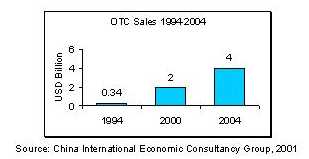Overview
OTC refers to those drugs that can be acquired through hospital pharmacies or retail pharmacies without prescriptions or guidance from medical practitioners, and are usually used to alleviate mild symptoms of diseases, or in treating mild diseases.
OTC sales worldwide have seen a dramatic rise since the early 1990s, with an annual growth greater than 30 percent. Some forecast that the world's average annual growth for OTC in the first decades of the 21st century will maintain 20 percent or above, with the fastest growth rates to be seen in East and Southeast Asia.
Current OTC sales in China represent 10-15 percent of the total synthetic drug market (including imported, JV and domestic products). The OTC proportion increases to around 30 percent in some of the more affluent regions in China. Based on the high growth rates over the past decade, averaging at 25 percent a year, it is projected that OTC sales will reach US$4 billion in 2004.

Market Drivers
Government Policy
A classification administrative system was set up by the State Drug Administration (SDA) in 1999 for prescription and OTC drugs. Since then, the SDA has issued a series of guidelines on interpretation of the new classification system, on labelling, usage instructions, and packaging of OTC products. The distinction between the two classes of drugs - prescription and OTC - is becoming clearer with time. At present, there are about 700 OTC drugs classified by the SDA. The second group of OTC drugs is under consultation with the industry. According to the SDA's plan, 70% of registered drugs will be classified as OTC.
Economic and Social Development
Awareness is increasing about health care and the importance of self-medication. The rapid rise in living standards and disposable income has made possible self-medication on a continued basis for a large number of people. Achievement of satisfactory results though such easy self-health management is winning over an incrasingly large number of people across age groups.
The domestic OTC market is also expanding as a result of rapid growth in OTC taret consumer populations. Currently, the total number of non-SOE workers (Who aren't covered by state health insurance) has overtaken that of SOE employees. Increased levels of international exchange and commercial activity have greatly added to the number of tourists and mobile populations, which, compared with other populations, tend to have higher incomes.
Large increases in rural migrant populations in urban areas have also contributed to the rise in OTC consumption, despite their relatively low earnings. These migrant workers fall outside the public health care insurance system, which is only available to urban SOE employees, and thus have to pay for hospital treatment and medication themselves. The ongoing and proposed future reforms to the healthcare insurance system will invariably divert more of the population to self-medication and OTC consumption.
Rural areas will become large potential markets for OTC drugs. The good safety and low toxicity, efficacy, ease of use, non-drug dependency, plus reasonable pricing, make OTC drugs ideal for the rural healthcare market where medical services are scarce and virtually non-existent in remote locations.
Technical Development
Adjustment in drug usage patterns will also push the OTC market forward. Traditionally, drugs for common diseases and symptoms have been dominant in the total drug consumption, thus underpinning stable growth of the OTC market. In recent years, the conversion from prescription to OTC medicines has become more frequent, resulting in a widening range of diseases and symptoms for which OTC drugs are effective. The nutritional supplements and medicated cosmetics in the OTC sector are increasing all the time, further enlarging the scope of OTC application.
Market Characteristics
Production and Price
Relatively simple off-patent technology makes entry barriers low. Brand sensitivity is much stronger than price sensitivity due to low price elasticity. It is very important to build branding and consumer awareness because of fragmentation of production and low price elasticity.
Promotion and Advertising
Normally, promotion and advertising expenditure account for 20-25% of the total sales turnover of OTC drugs. Advertising expenditure on TV dominates. Other promotion tools include POP and medical magazines.
Distribution Channels
Distribution channels include chain pharmacies, hospitals, direct sales and department stores and supermarkets. China抯 medicine distribution industry has been controlled by the government for decades, and chain pharmacies have appeared only in the past five years. The increase in OTC sales has led to rapid development of chain pharmacies in Chinese cities. In 2000, there were about 200 intra-province chain pharmacies with 5,000 outlets. Sales by chain pharmacies in coastal cities increased by 45% in 2001.
Opportunities for Foreign Companies in OTC Distribution
According to China抯 WTO agreements, from 1st January of 2003, foreign investment in wholesaling and retailing of drugs will be allowed. Prior to that date, trial run of foreign invested joint venture drug trade companies will be implemented under the control and guidance of the State Economic and Trade Commission (SETC) and Ministry of Foreign Trade and Economic Cooperation (MOFTEC). The trial run is characterized as follows:
-
The two figures on the same conditions for the Chinese side shall be more than RMB50 million (US$6.02 million) and RMB300 million (US$36.14 million) respectively. The requirements for domestic companies in the western and central regions are set at RMB30 million (US$3.61 million) and RMB200 million (US$24.10 million) respectively. Furthermore, if the domestic operator is a foreign trade enterprise, its annual foreign trade volume shall exceed US$50 million for three consecutive years before the application, among which US$30 million should be gained from exports. Moreover, if the Chinese partner is a pharmaceutical wholesaler, the domestic equity for the joint venture shall be more than 51 percent.
|







